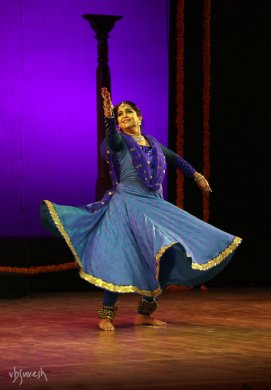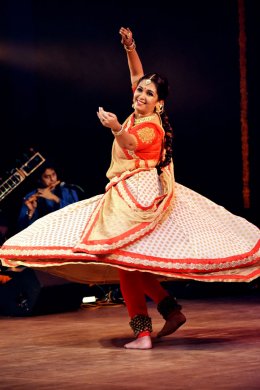
|   |

|   |
She sang and danced with aplomb - Jyothi Raghuram e-mail: jyothi.r.ram@gmail.com Photos: VB Suresh June 30, 2018 Clichéd as it may sound, the gain of the world of film music was the loss of Hindustani vocal, or so one thought of Samanvitha Sharma, whose dulcet voice and enviable range of traversing octaves with ease, held the promise of a rising star on the classical music scene, before she decided to focus on film music. Kathak, of course, remained on her horizon, her becoming an integral part of the senior performing troupe of NADAM (Narthan Academy of Dance and Music) vouching for it. Yet her solo Kathak recital, Samaavartan, happily proved one wrong, in that her music still echoes a classicism that can be put to good use in dance, which she did; and this was the unique aspect of her outing at the ADA Rangamandira in Bengaluru on June 17, 2018. Off-beat, it was not, in content, Ganesha Vandana, Teentaal, Thumri, bhajan and the Taraana being among her chosen pieces. Even as Samanvitha began with Gajavadana Beduve (Basant), she established her stage presence, exuding a self confidence born out of familiarity with the stage. It was an invocatory piece replete with imagery, the representative movements of the deity speaking of a deeper understanding of the art, which extended beyond the pictorial. Samanvitha’s Teentaal had all the embellishments intact, finished with well-timed accuracy, from the bols of the pakhawaj (paran) to the tukras with their characteristic offbeat patterns, and the tihais culminating in the signature chakkars of Kathak. The gat embodied the casual yet interesting bits of everyday life, as in a woman picking flowers and stringing them together into a garland and admiring herself in it. Adding a touch of spontaneity by portraying a greenroom experience just before her recital, she gave it a humorous twist, resourceful as her thinking was! The attractive asymmetric patterns in the 14-beat Taal Dhamar, showcased excellent footwork in different tempos, the stage literally resounding with the precision and strength of it. Such was the clarity that it was as if the intricacies of her footwork were echoed in the percussion, instead of vice versa. Incorporating a bandish with tihais and tukras, the Taal Dhamar concluded with an ode to Lord Shiva. Anup Jalota’s bhajan, Jag Mein Sundar, was formatted more as an interactive item, reaching a crescendo of audience participation. 

As much as it was a dance recital, the flavor of the evening was Samanvitha’s singing, where one was interwoven into the other, both in the music and in the padanth. Her enunciation of the syllables correlating to the percussion was commendable, their lexicon and tonal variations finding a tensile strength in her rendering. Her vocal rendering of the thumri, Mohe Chedo Na, was lilting. Murali Mohan Kalva (padanth), with his well cultivated voice, diction, and hold, was an ace in the wings, Nandini Mehta’s padanth and presence being another support factor. The combination of Praveen D Rao (tabla), Sarfaraz Khan (sarangi), Gurumurthy Vaidya (pakhawaj), Shruti Kamat (sitar), Prakash Hegde (flute) and Ganesh Hegde (harmonium and vocal) was a show of musical strength. Although touted as an interactive show, what ate into Samanvitha’s dance was the almost incessant talk that went into the beginning of each recital, sometimes even halfway through it. It watered down the seriousness of the recital itself, making one wonder at times whether it was a talk show. Costuming could have been a little more attractive. Much credit goes to Kalva and Mehta, founders of NADAM, a premiere Kathak institute of the country, for putting together a recital not just tailored to a senior dancer of their institute, but to a star playback singer, without falling prey to playing to the gallery. Jyothi Raghuram is a freelance journalist, dance critic and project writer for UNESCO. A senior journalist with an experience of three decades, she has worked with BBC, PTI, The Hindu and Indian Express. |